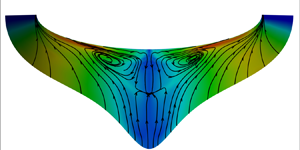No CrossRef data available.
Article contents
Hypersonic turbulent boundary layer over the windward side of a lifting body
Published online by Cambridge University Press: 03 June 2024
Abstract

In the present study, we performed direct numerical simulations for a hypersonic turbulent boundary layer over the windward side of a lifting body, the HyTRV model, at Mach number  $6$ and attack angle 2
$6$ and attack angle 2 $^{\circ }$ to investigate the global and local turbulent features, and evaluate its difference from canonical turbulent boundary layers. By scrutinizing the instantaneous and averaged flow fields, we found that the transverse curvature on the windward side of the HyTRV model induces the transverse opposing pressure gradients that push the flow on both sides towards the windward symmetry plane, yielding significant effects of the azimuthal inhomogeneity and large-scale cross-stream circulations, moderate and azimuthal independent influences of adverse pressure gradient, and negligible impact of the mean flow three-dimensionality. Further inspecting the local turbulent statistics, we identified that the mean and fluctuating velocity become increasingly similar to the highly decelerated turbulent boundary layers over flat plates in that the mean velocity deficit is enhanced, and the outer layer Reynolds stresses are amplified as it approaches the windward symmetry plane, and prove to be self-similar under the scaling of Wei & Knopp (J. Fluid Mech., vol. 958, 2023, A9) for adverse-pressure-gradient turbulent boundary layers. Conditionally averaged Reynolds stresses based on strong sweeping and ejection events demonstrated that the Kelvin–Helmholtz instability of the strong embedded shear layer induced by the large-scale cross-stream circulations is responsible for the turbulence amplification in the outer layer. The strong Reynolds analogy that relates the mean velocity and temperature was refined to incorporate the non-canonical effects, showing considerable improvements in the accuracy of such a formula. On the other hand, the temperature fluctuations are still transported passively, as indicated by their resemblance to the velocity. The conclusions obtained in the present study provide potentially profitable information for turbulent modelling modification for the accurate predictions of skin friction and wall heat transfer.
$^{\circ }$ to investigate the global and local turbulent features, and evaluate its difference from canonical turbulent boundary layers. By scrutinizing the instantaneous and averaged flow fields, we found that the transverse curvature on the windward side of the HyTRV model induces the transverse opposing pressure gradients that push the flow on both sides towards the windward symmetry plane, yielding significant effects of the azimuthal inhomogeneity and large-scale cross-stream circulations, moderate and azimuthal independent influences of adverse pressure gradient, and negligible impact of the mean flow three-dimensionality. Further inspecting the local turbulent statistics, we identified that the mean and fluctuating velocity become increasingly similar to the highly decelerated turbulent boundary layers over flat plates in that the mean velocity deficit is enhanced, and the outer layer Reynolds stresses are amplified as it approaches the windward symmetry plane, and prove to be self-similar under the scaling of Wei & Knopp (J. Fluid Mech., vol. 958, 2023, A9) for adverse-pressure-gradient turbulent boundary layers. Conditionally averaged Reynolds stresses based on strong sweeping and ejection events demonstrated that the Kelvin–Helmholtz instability of the strong embedded shear layer induced by the large-scale cross-stream circulations is responsible for the turbulence amplification in the outer layer. The strong Reynolds analogy that relates the mean velocity and temperature was refined to incorporate the non-canonical effects, showing considerable improvements in the accuracy of such a formula. On the other hand, the temperature fluctuations are still transported passively, as indicated by their resemblance to the velocity. The conclusions obtained in the present study provide potentially profitable information for turbulent modelling modification for the accurate predictions of skin friction and wall heat transfer.
JFM classification
- Type
- JFM Papers
- Information
- Copyright
- © The Author(s), 2024. Published by Cambridge University Press





